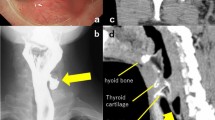Abstract
The etiopathogenesis of Zenker’s diverticulum (ZD) remains uncertain. Increased hypopharyngeal pressure due to a hypertonic upper esophageal sphincter results in herniation proximal to the sphincter producing a pulsion diverticulum. Gastroesophageal reflux, which is known to induce shortening of the injured esophagus, likely plays a prominent role in ZD formation by pulling the cricopharyngeus muscle (CPM) away from the anchored inferior constrictor muscle. This creates a “weak zone” encouraging herniation. A bilobed diverticulum may originate from continuation of the fibrous midline raphe inferiorly to developmentally include part of the CPM. We report using laser endoscopy to divide the inter-diverticular septum followed by transmucosal cricopharyngeus myotomy. Presentation of a rare, bilobed diverticulum emphasizes the importance of the midline prevertebral raphe in anchoring the pharyngeal constrictor muscles with respect to the CPM. This lends support to the hypothesis that the etiopathogenesis of ZD is multifactorial while guiding us to a unified understanding of ZD.


Similar content being viewed by others
References
Chernichenko N, Woo JS, Hundal JS, Sasaki CT. Response of cricopharyngeus muscle to esophageal stimulation by mechanical distension and acid and bile perfusion. Ann Otol Rhinol Laryngol. 2011;120(2):137–42.
Fulp SR, Castell DO. Manometric aspect of Zenker’s diverticulum. Hepatogastroenterology. 1992;39(2):123–6.
Shirazi S, Schulze-Delrieu K, Custer-Hagen T, et al. Motility changes in oppossum esophagus from experiemtnal esophagitis. Dig Dis Sci. 1989;34:1668–76.
Sasaki CT, Ross DA, Hundal J. Association between zenker diverticulum and gastroesophageal reflux disease: development of a working hypothesis. Am J Med. 2003;115(3A):169S–71S.
Author information
Authors and Affiliations
Corresponding author
Ethics declarations
Conflict of interest
The authors declare that there is no conflict of interest.
Additional information
Publisher's Note
Springer Nature remains neutral with regard to jurisdictional claims in published maps and institutional affiliations.
Rights and permissions
About this article
Cite this article
Kasle, D.A., Torabi, S.J., Boey, H. et al. Hypopharyngeal Diverticulum: Toward a Unified Understanding of Its Etiopathogenesis. Dysphagia 34, 713–715 (2019). https://doi.org/10.1007/s00455-019-10030-z
Received:
Revised:
Accepted:
Published:
Issue Date:
DOI: https://doi.org/10.1007/s00455-019-10030-z




